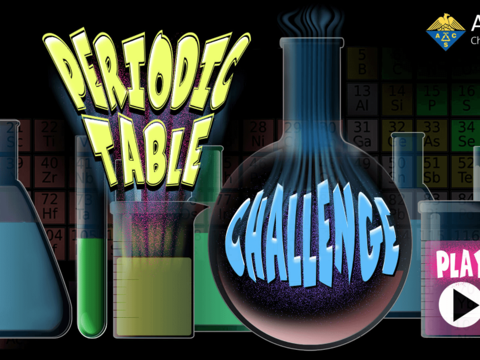The Periodic Table and Energy-Level Models
Lesson Summary Video for teachers
Note: This video is designed to help the teacher better understand the lesson and is NOT intended to be shown to students. It includes observations and conclusions that students are meant to make on their own.
Key Concepts
- The electrons surrounding an atom are located in regions around the nucleus called “energy levels”.
- An energy level represents the 3-dimensional space surrounding the nucleus where electrons are most likely to be.
- The first energy level is closest to the nucleus. The second energy level is a little farther away than the first. The third is a little farther away than the second, and so on.
- Each energy level can accommodate or “hold” a different number of electrons before additional electrons begin to go into the next level.
- When the first energy level has 2 electrons, the next electrons go into the second energy level until the second level has 8 electrons.
- When the second energy level has 8 electrons, the next electrons go into the third energy level until the third level has 8 electrons.
- When the third energy level has 8 electrons, the next 2 electrons go into the fourth energy level.
- The electrons in the energy level farthest from the nucleus are called valence electrons.
- Atoms in the same column (group) in the periodic table have the same number of valence electrons.
Summary
Students will again focus on the first 20 elements. Students will first look at a diagram and animation to understand the basic pattern of the arrangement of electrons on energy levels around an atom. Students will be given cards with information about the electrons and energy levels for each of the first 20 atoms. They will again try to correctly match the cards with each element.
Objective
Students will be able to interpret the information given in the periodic table to describe the arrangement of electrons on the energy levels around an atom.
About this Lesson
Be sure that the 20 atom name cards are posted around the room. You will need the five cards on the right-hand side of each sheet. This lesson is intended as a follow-up to chapter 4, lesson 2.
Students can try playing the Periodic Table Game, Game #2. This is an online version of the periodic table card game from this lesson that you can assign as class work or homework after students have played the game in the classroom.
Print out the Element Cards and play the Periodic Table Game, Game #2.
- Lesson 4.2 and 4.3 Element Cards PDF
Download All Lesson 4.3 Resources
Get the entire lesson plan and Student Activity Sheet for "Lesson 4.3 - The Periodic Table and Energy-Level Models."
Online Assignments
Supplement in-class learning with interactive, multimedia-rich Google Forms lesson modules, perfect for reinforcing key chemistry concepts and scientific investigation skills.
Instructions
1 Engage
Step 1
Introduce students to the idea that electrons surround the nucleus of an atom in regions called energy levels.
Review with students that in lesson two they focused on the number of protons, neutrons, and electrons in the atoms in each element. In this lesson, they will focus on the arrangement of the electrons in each element.
Project the image Energy level cross-section.
Explain to students that electrons surround the nucleus of an atom in three dimensions, making atoms spherical. They can think of electrons as being in the different energy levels like concentric spheres around the nucleus. Since it is very difficult to show these spheres, the energy levels are typically shown in 2 dimensions.
Project the image Oxygen atom.
Tell students that this energy level model represents an oxygen atom. The nucleus is represented by a dot in the center, which contains both protons and neutrons. The smaller dots surrounding the nucleus represent electrons in the energy levels. Let students know that they will learn more about electrons and energy levels later in this lesson.
Have students look at the Periodic table of the elements 1–20 they used in lesson 2 to answer the following question:
- How do you know this model is an oxygen atom?
If students can’t answer this question, point out that there are 8 electrons. Because neutral atoms in the periodic table have the same number of electrons as protons, the atom must have 8 protons. The number of protons is the same as the atomic number, so the atom is oxygen.
Read more about The Periodic Table and Energy-Level Models in the Teacher Background.
- Lesson 4.3 Teacher Background PDF
Step 2
Have groups work together to place each card with its correct atom.

Show students that you have 80 cards (4 for each of the first 20 elements). Before distributing the cards, explain that each card contains information about electrons and energy levels for the first 20 elements of the periodic table.
The students’ job is to read the card carefully, figure out which element the card is describing, and put the card at the spot in the room for that element. Remind students that they will need to count the electrons in order to identify each atom. Once students understand what their assignment is, distribute the cards to groups.
Step 3
Discuss the placement of the cards for two or three atoms.
After all cards have been placed at the 20 different atoms, select two or three atoms and review whether the cards were placed correctly. This review will help reinforce the concepts about the structure of atoms and help students determine the number of protons and electrons in each atom.
2 Evaluate
Give each student a Periodic Table of Energy Levels activity sheet. This table contains energy level models for the first 20 elements. The electrons are included only for the atoms at the beginning and end of each period.
- Lesson 4.3 Student Activity Sheet PDF | DOCX | Google Doc
- Lesson 4.3 Activity Sheet Answers PDF | DOCX | Google Doc
Download the student activity sheet, and distribute one per student.
The activity sheet will serve as the “Evaluate” component of each 5-E lesson plan. The activity sheets are formative assessments of student progress and understanding.
3 Explore
Step 4
Project the Periodic table of energy levels and discuss the arrangement of electrons as students complete their activity sheet.
Project the image Periodic table of energy levels.
The image you project contains all of the electrons for elements 1–20. However, the periodic table on the activity sheet contains electrons only for the elements at the beginning and end of each period. Discuss the arrangement of electrons within the energy levels for these atoms and have students fill in the electrons for the other atoms.
Note: In the energy level diagrams, the electrons are spread out evenly in the level. Some books show them spread out this way and some show them in pairs. The pairing of electrons is meant to represent that pairs of electrons are in separate orbitals within each energy level. At the middle school level, it is not necessary for students to learn about electron orbitals. This information is offered so that it is clearer to you why electrons are often shown in pairs in energy level diagrams. An orbital defines a region within an energy level where there is a high probability of finding a pair of electrons. There can be a maximum of two electrons in each orbital. This is why the electrons are often shown in pairs within an energy level.
Tell students that the rows across on the periodic table are called periods.
Period 1
- Hydrogen
Explain that hydrogen has 1 proton and 1 electron. The 1 electron is on the first energy level. - Helium
Explain that helium has 2 protons and 2 electrons. The 2 electrons are on the first energy level.
Period 2
- Lithium
Explain that lithium has 3 protons and 3 electrons. There are 2 electrons on the first energy level and 1 electron on the second. Explain that the first energy level can only have 2 electrons so the next electron in lithium is on the next (second) level. - Neon
Explain that neon has 10 protons and 10 electrons. There are 2 electrons on the first energy level and 8 electrons on the second level. - Beryllium–fluorine
Help students fill in the correct number of electrons in the energy levels for the rest of the atoms in period 2.
Period 3
- Sodium
Explain that sodium has 11 protons and 11 electrons. There are 2 electrons on the first energy level, 8 electrons on the second level, and 1 electron on the third energy level. Explain that the second energy level can only have 8 electrons so the next electron in sodium must be on the next (third) level. - Argon
Explain that argon has 18 protons and 18 electrons. There are 2 electrons on the first energy level, 8 electrons on the second level, and 8 electrons on the third energy lev- el. Have students complete the energy level model for argon in their periodic table. - Magnesium–chlorine
Help students fill in the correct number of electrons in the energy levels for the rest of the atoms in period 3.
Period 4
- Potassium
Explain that potassium has 19 protons and 19 electrons. There are 2 electrons on the first energy level, 8 electrons on the second level, 8 electrons on the third energy level, and 1 on the fourth energy level. Explain that after the third energy level has 8 electrons, the next electron goes into the fourth level. - Calcium
Help students fill in the correct number of electrons in the energy levels for calcium.
Note: Students may wonder why an energy level can hold only a certain number of electrons. The answer to this is far beyond the scope of a middle school chemistry unit. It involves thinking of electrons as 3-dimensional waves and how they would interact with each other and the nucleus.
3 Explain
Step 5
Have students look for patterns in rows and columns of the first 20 elements in the periodic table.
Continue to project the image Periodic table of energy levels for elements 1–20 and have students look at their activity sheets to find patterns in the number of electrons within each energy level.
Have students look at the periods (rows going across).
Number of energy levels in each period
- The atoms in the first period have electrons in 1 energy level.
- The atoms in the second period have electrons in 2 energy levels.
- The atoms in the third period have electrons in 3 energy levels.
- The atoms in the fourth period have electrons in 4 energy levels.
How the electrons fill in the energy levels
- First energy level = 1, 2
- Second energy level = 1, 2, 3, …8
- Third energy level = 1, 2, 3, …8
- Fourth energy level = 1, 2
A certain number of electrons go into a level before the next level can have electrons in it. After the first energy level contains 2 electrons (helium), the next electrons go into the second energy level. After the second energy level has 8 electrons (neon), the next electrons go into the third energy level. After the third energy level has 8 electrons (argon), the next 2 electrons go into the fourth energy level.
Note: The third energy level can actually hold up to 18 electrons, so it is not really filled when it has 8 electrons in it. But when the third level contains 8 electrons, the next 2 electrons go into the fourth level. Then, believe it or not, 10 more electrons continue to fill up the rest of the third level. Students do not need to know this.
Have students look at the groups (columns going down).
Tell students that the vertical columns in the periodic table are called groups or families. Ask students to compare the number of electrons in the outermost energy level for the atoms in a group. Students should realize that each atom in a group has the same number of electrons in its outermost energy level. For instance, hydrogen, lithium, sodium, and potassium all have 1 electron on their outer energy level. Let students know that these electrons in the outermost energy level are called valence electrons. They are the electrons responsible for bonding, which students will investigate in the next lesson.
Read more about The Periodic Table and Energy-Level Models in the Teacher Background.
- Lesson 4.3 Teacher Background PDF
4 Extend
Step 6
Compare the way different elements react chemically and relate this to their location on the periodic table.
Tell students that in the periodic table atoms in the same column, called a group, share certain characteristics and can react in a similar way.
Project the videos Sodium in water and potassium in water.
Students will see that although potassium reacts more vigorously than sodium, the reactions are similar. Have students look at the periodic table to see where sodium and potassium are in relation to one another.
Project the video Calcium in water.
Students will see that this reaction is different from the sodium and the potassium. Have them locate calcium on the periodic table and point out that it is in a different group than sodium and potassium.
Project the videos Sodium in acid and potassium in acid.
Show sodium reacting with acid and then potassium reacting with acid. The HCl is hydrochloric acid. The HNO3 is nitric acid. Each acid is used in two different concentrations.
Make sure students realize that the sodium and potassium react in a similar way even though the potassium reacts more vigorously.
Project the video Calcium in acid.
Point out that calcium reacts differently from the sodium and the potassium.
Ask students:
Do elements in the same group have similar properties and react in similar ways?
Students should realize that sodium and potassium are in the same group and react similarly. Calcium is near them on the periodic table, but is in a different group, so it reacts differently.
What is the 5-E format?
The 5-E instructional model is an approach to teaching and learning that focuses on active engagement, inquiry-based learning, and collaboration.
Downloads
- Lesson 4.3 Student Activity Sheet PDF | DOCX | Google Doc
For Teachers
- Lesson 4.3 Lesson Plan PDF | DOCX | Google Doc
- Lesson 4.3 Activity Sheet Answers PDF | DOCX | Google Doc
- Lesson 4.2 and 4.3 Element Cards PDF
- Lesson 4.3 Teacher Background PDF
Resources for the entire Chapter 4
- Chapter 4 Student Reading PDF | DOCX | Google Doc
- Chapter 4 Test Bank PDF | DOCX | Google Doc
Interactive Lesson Modules
- Lesson 4.3 Online Assignments Google Form
Have Questions? Visit Help Center


















